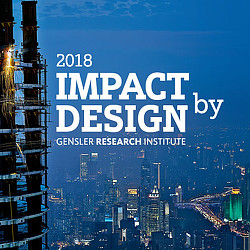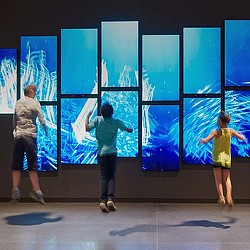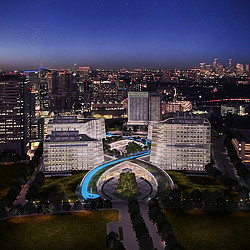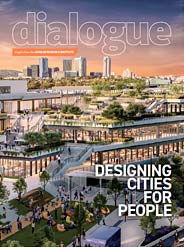Reed Smith — Chicago
In the renovated offices of Reed Smith, the connecting stair features a custom map of the city, showcasing the firm’s pride in its location.
Meanwhile, questions about the role of technology in urban life have created something of a smart city backlash. In Toronto, where Alphabet’s Sidewalk Labs is planning to construct a smart neighborhood, citizen groups are balking at handing public space over to private companies. In New Orleans and Chicago, activists have decried secret surveillance programs by data-mining companies. The term “smart city” has become so loaded that some of its main boosters, including Sidewalk Labs CEO Dan Doctoroff, tend to avoid using it.
TECHNOLOGY IN SERVICE TO PEOPLE
Whatever we call them, smart city technologies are not going anywhere anytime soon. If early experiments have taught us anything, it’s that these technologies need to be directed toward pre-identified and necessary purposes, and that the urban citizen receives a tangible benefit from them. In other words, smart cities need to be humanized.

At the city level, Barcelona is leading the way with its Smart City 3.0 strategy, which emphasizes citizen empowerment rather than data (and profit) extraction. At the center of the strategy is what the city’s Chief Technology and Innovation Officer Francesca Bria calls a “new pact on data.” Her belief that cities can be the “custodians for the new digital rights” is surely welcome news to those concerned about data privacy.
A human-centered smart city philosophy could make an even greater impact at the individual building and development scale. In designing spaces outfitted with smart city technologies, Gensler starts by engaging clients on the human value conversation before the financial conversation. For example, key elements of our process as digital experience designers include questions like: What needs will this technology fulfill? How will users engage with it?
IDEAS FOR A MORE CONNECTED CITY
Instead of solely orienting around profit per square foot, we invite developers to think about experience per square foot. At the building scale, smart systems can augment human ability and cater to detailed individual needs by automating dozens of tasks or cross-referencing information for truly personalized experiences. At the skyline level, we can use digital displays like those framing the Shanghai Tower to bring silent and static urban landscapes to life and tell a collective story in which everyone can find meaning.
Transparency and user education are key to implementing smart city technologies at a more intimate level. Many technologies should be opt-in/opt-out, like the qualitative data that informs lighting, heating, and cooling. In an era when critics lament that technology is being used to address the wrong problems, properly deployed technology can ensure that we’re solving problems that need to be solved.
When done right, smart city technologies can provide a platform for a two-way dialogue between citizen and city, and architects are in the unique position of demonstrating how this can work in practice at a limited scale. Designs are only successful to the extent that people use and appreciate them. In the smart city age, architects have an obligation to model that ethic for all who build cities.










